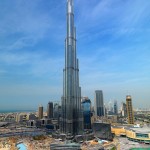Source: www.meed.com
Tall towers have come to symbolise the excesses of the boom years. The focus must be on city centres instead
 Makkah’s Clock Royal Tower, the world’s second tallest tower at 577 metres, is scheduled to be complete in August this year.
Makkah’s Clock Royal Tower, the world’s second tallest tower at 577 metres, is scheduled to be complete in August this year.
If the project meets its completion deadline, it comes just eight months after the opening of the world’s tallest tower, Dubai’s 828-metre Burj Khalifa.
The high-rise boom shows no sign of slowing. The Makkah project is being financed by Kingdom Holding Company, which is currently planning to build a 1.1-kilometre-high tower at its Kingdom City development in Jeddah. But why are developers seemingly obsessed with record-breaking towers?
The allure is easy to understand. Tall towers capture the imagination and are conversation starters. They bestow bragging rights and allow people who do not understand much about architecture, development or construction, to sound like they are on top of the regional real estate boom.
But the recession raises serious questions about whether tall towers still make sense.
For developers in the Gulf, tall towers have been used as a catalyst for transforming once-barren land into densely populated cities. While cities such New York, Tokyo and more recently Dubai, no longer need tall towers – they already have enough, some of the region’s cities still need to create new urban areas to plug gaps in the real estate market.
Tall towers may help get these projects started, but the danger is they create standalone projects that are islands of development marooned in the middle of a barren desert or sprawling construction sites.
If developers want to make tall towers work, they should direct their attentions to creating vibrant city centres. People will come to see a tall tower, but they will stay, live, work and play if you give them an experience.












